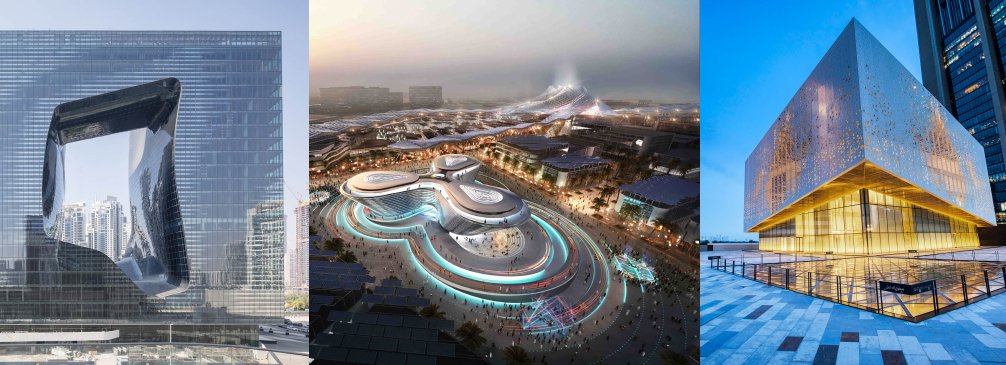Cosentino at Expo 2020 + C Guide
C guide welcomes the new year by incorporating Dubai, the city that is finalising the details of the World Expo
-
In little over a year, since its launch in late 2019, C guide provides users with leading contemporary architecture from eight major cities, namely London, Los Angeles, Barcelona, Paris, Sydney, Amsterdam, Chicago and Dubai, which add up to nearly 1,600 projects.
-
The Dubai Expo will be a very important space for collective reflection on the upcoming global and local challenges and the role that our cities must play in them.
-
The content is now available for free on the web platform www.c.guide and the app for mobile devices (iOS and Android).
With the arrival of the new year, the Foundation for Contemporary Architecture and Cosentino incorporates in the C guide a series of projects from Dubai, a city where work is still underway to host the World Expo whose opening, scheduled for 2020, had to be postponed until October this year due to the coronavirus pandemic.
This city, which emerged from the desert, built its first skyscraper in 1979 and has since become one of the world’s leading references for high-rise architecture. Works by major firms such as the Index Tower by Foster + Partners or the Cayan Tower by SOM contribute to the city’s skyline. It is also worth mentioning the Burj Khalifa Tower, which at 830 metres high is the tallest building in the world and is definitely a landmark in the city.
Dubai’s interest in becoming a global tourist destination can be seen in an architecture of great formal expressiveness that aims to make urban spaces more attractive. Buildings such as the Opus by Zaha Hadid or the new metro stations by Aedas are examples of this iconic desire for contemporary architecture in the city.
Another of the city’s strategic commitments for the future is to promote cultural activity. Works such as the Concrete Arts Centre at Alserkal Avenue -designed by OMA as a centre of creation in the middle of an industrial area-, or the Etihad Museum and the Jameel Arts Centre, are examples of high quality architecture designed to promote culture and art in the city.
This is the context for the Dubai Expo, which is a unique event to reflect on the places we live in and to think about their future, focusing on sustainability. The Expo, where Cosentino will be present as a collaborating company in the construction of the Spanish Pavilion, will also be a great opportunity to analyse the consequences of the development effort and propose strategies that are in line with the territory and local culture, in accordance with what the United Nations advocates in the New Urban Agenda.
Important architectural firms from all over the world will be represented through the different national and themed pavilions. C guide, as a guide with a global vision that is constantly being updated, will be at the event to include the most outstanding works and contribute from architecture to the conversation about the future of our cities.
More information about C guide
Resources:
-
Website: www.c.guide
-
App (iOS)
-
App (Android)
-
Social networks (Facebook, Twitter e Instagram): @cguidearch
Projects
Given its contemporary subject matter, C guide only includes works built from 1979 onwards, providing a perspective of 40 years that helps to reflect on global architecture as a whole. The works included in the guide are chosen by a scientific committee from the Foundation of Contemporary Architecture, who take into account three categories of interest:
-
Global-local tension: projects with two opposing views that look to reinforce the local specificities of each city and/or that are more inclined towards representing the world’s spatial homogenisation.
-
Symbolic function: projects that generate collective participative processes, spaces that symbolise the emergence of geographical identities and/or places that have generated a special relevance in the collective imagination because of their appearance in cinema or the media.
-
Public space: works that play an urban role – in particular those that become a meeting or exchange point in the city and/or that play a crucial role in our understanding of today’s cities.
The projects included in C guide are classified into three categories:
-
C: Very good architecture. Don’t miss this site if you are in the area
-
CC: Excellent architecture. A must-see site if you are in the city
-
CCC: Outstanding architecture. Don’t miss this site no matter where you are
Users can participate
Each project in the guide features its own image gallery (some also include plans or drawings of the design process) and a file that includes a description of the work, the designer, year of construction, location, category (C, CC, CCC), how easily you can visit it (if you can visit it, if it’s visible from the street, scheduled visits or unavailable for visits) and tags (that help you understand them and which are put forward by the C guide committee as well as by the users themselves). The platform offers users the ability to perform a quick search, considering the same parameters included in the file for each project.

